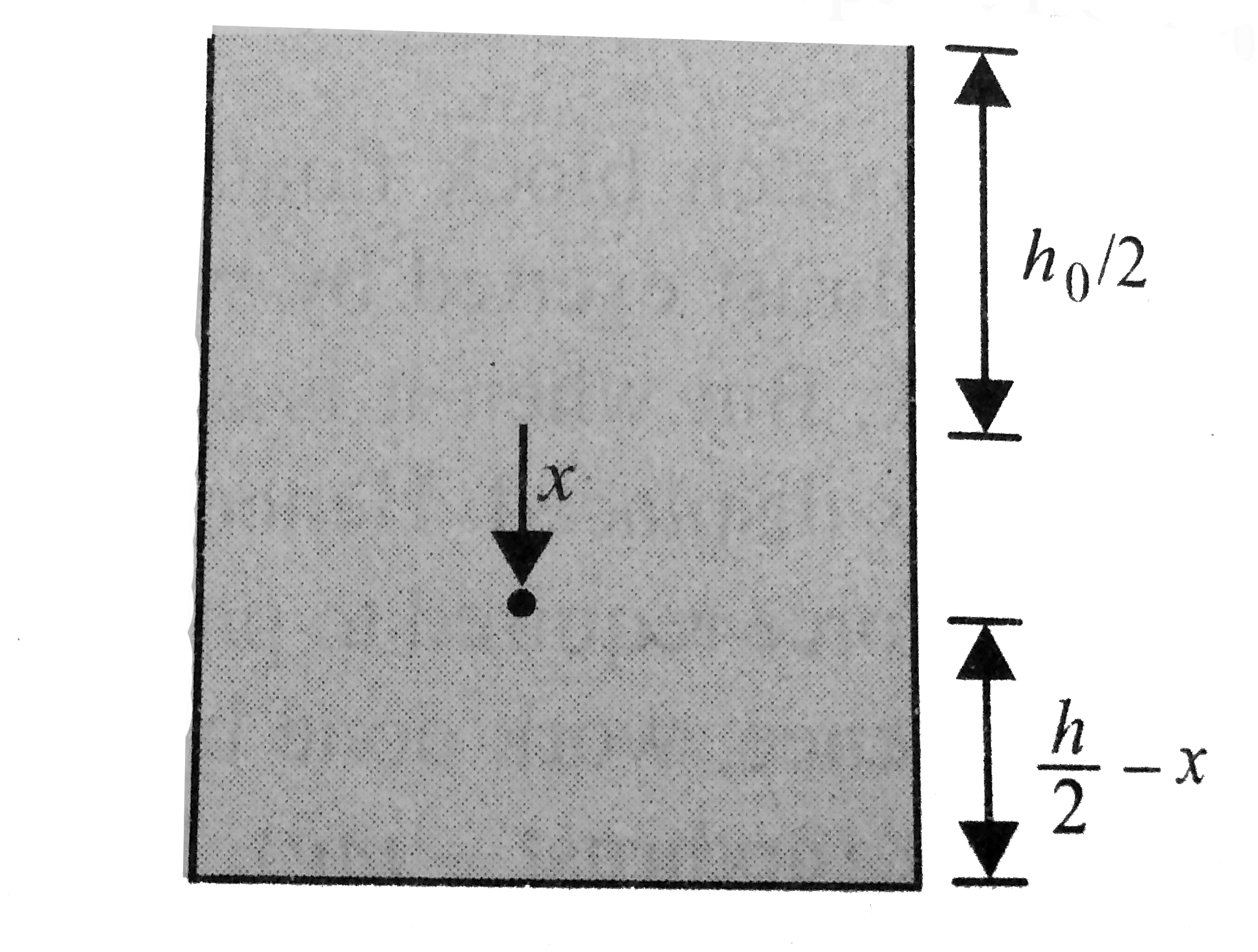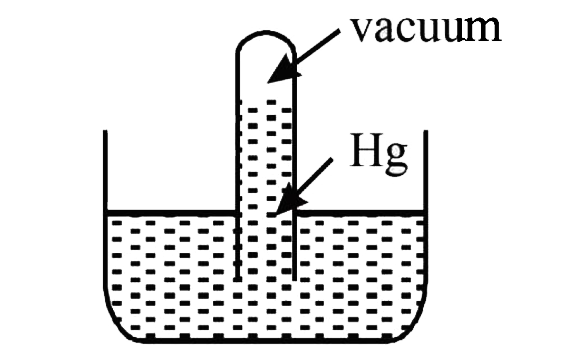A small spherical ball of radius r is released from its completely submerged Position (as shown in the figure) in a liquid whose density varies with height h (measured from the bottom) as ρL=ρ0[4−(3h/h0)].The density of the ball is (5/2)ρ0. The height of the vessel is h0=12/π2 Consider r<<h0 and g=10m/s2.
![A small spherical ball of radius r is released from its completely submerged Position (as shown in the figure) in a liquid whose density varies with height h (measured from the bottom) as rho(L)=rho(0)[4-(3h//h(0))].The density of the ball is (5//2)rho(0). The height of the vessel is h(0)=12//pi^(2) Consider r lt lt h(0) and g = 10 m//s^(2). The motion of the ball in the vessel is](https://d10lpgp6xz60nq.cloudfront.net/physics_images/BMS_VOL2_C04_E01_186_Q01.png)
The motion of the ball in the vessel is
oscillatory but not simple harmonic motion
simple harmonic motion with time period 2s
simple harmonic motion with time period 1s
the motion is not oscillatory
The correct Answer is:B
Let the net force on this particle be zero at height h. Then weight
= upthrust (at h)
⇒43πr3g52ρ0−43πr2gρ0[4−3hh0]
⇒3hh0=4−52=32⇒h=h02………..i
Therefore, at h=h02, the equilibrium position, the particle has a speed in downward direction due to which it will move downward. Let at a further depth x from h02.

Fnet= upthrust − weight
=43πr3gρ0⎡⎢
⎢⎣4−3(h02−x)h0⎤⎥
⎥⎦−43πr3g52ρ0
=43πr3ρ0g[4−32+3xh0−52]=4πr3ρ0gh0x
∴F=4πr3ρ0gh0x
Since the net force on the and displacement of ball from its mean position are oppositely directed the particle executes SHM about its mean position i.e. h=h02
∴F=ma=−4πr3ρ0gh0x
=43πr352ρ0a=−4πr3ρ0gh0x
⇒a=−6g5h0x=−(12h0)x=−ω2x
where ω=√12h0=s√1212πr2=π
Hence, time taken by the particle to reach the bottom is
t=T2=122πω=πω=ππ=1s
Topper's Solved these Questions
- FLUID MECHANICSBook:CENGAGE PHYSICSChapter:FLUID MECHANICSExercise:True/False
Explore 1 Video
- FLUID MECHANICSBook:CENGAGE PHYSICSChapter:FLUID MECHANICSExercise:SCQ_TYPE
Explore 13 Videos
- FLUID MECHANICSBook:CENGAGE PHYSICSChapter:FLUID MECHANICSExercise:Assertion-Reasoning
Explore 8 Videos
- DIMENSIONS & MEASUREMENTBook:CENGAGE PHYSICSChapter:DIMENSIONS & MEASUREMENTExercise:Integer
Explore 2 Videos
- GRAVITATIONBook:CENGAGE PHYSICSChapter:GRAVITATIONExercise:INTEGER_TYPE
Explore 1 Video
Similar Questions
A barometer made of very narrow tuve (see fig) is placed at normal temperature and pressure. The coefficient of volume expansion of mercury is 0.00018perC∘ and that of the tube is negligible. The temperature of mercury in the barometer is now raised by 1∘C, but the temperature of the atmosphere does not raised by 1∘C, but the temperature of the atmosphere does not change. Then the mercury height in the tube remains unchanged.

View SolutionA metal ball immersed in alcohol weights W1 at 0∘C and W2 at 50∘C. The coefficient of expansion of cubical the metal is less than that of the alcohol. Assuming that the density of the metal is large compared to that of alcohol, it can be shown that
View SolutionAssertion: Pascal law is the working principle of hydraulic lift.
Reason: Pressure =thrustarea
View SolutionTo find the distance d over which a signal can be seen clearly in foggy conditions, a railways-engineer uses dimensions and assumes that the distance depends on the mass density ρ of the fog, intensity (power/area) S of the light from the signal and its frequency f. the engineer finds that d is proportional to S1/n. the value of n is
View SolutionGravitational acceleration on the surface of the planet is √611g. where g is the gravitational acceleration on the surface of the earth. The average mass density of the planet is 23 times that of the earth. If the escape speed on the surface of the earth is taken to be 11kms−1 the escape speed on the surface of the planet in kms−1 will be
View SolutionFigure shown a container having liquid of variable density. The density of liquid veriesas rho=rho_(0)(4-(3h)/(h_(0))) . Here, h_(0) and rho_(0) are constants and h is measured from bottom of the container. A solid block of small dimensions whose density is (5)/(2) rho_(0) and mass m is released from bottom of the tank. Prove that the block will execute simple harmonic motion. Find the frequency of oscillation. .
View SolutionA small spherical ball of radius r is released from its completely submerged Position (as shown in the figure) in a liquid whose density varies with height h (measured from the bottom) as rho_(L)=rho_(0)[4-(3h//h_(0))] .The density of the ball is ( 5//2)rho_(0) . The height of the vessel is h_(0)=12//pi^(2) Consider r lt lt h_(0) and g = 10 m//s^(2) . Where will the ball come in the equilibrium?
View SolutionA small spherical ball of radius r is released from its completely submerged Position (as shown in the figure) in a liquid whose density varies with height h (measured from the bottom) as rho_(L)=rho_(0)[4-(3h//h_(0))] .The density of the ball is ( 5//2)rho_(0) . The height of the vessel is h_(0)=12//pi^(2) Consider r lt lt h_(0) and g = 10 m//s^(2) . The ball will reach at the bottom of the vessel
View SolutionA solid uniform ball having volume V and density rho floats at the interface of two unmixible liquids as shown in Fig. 7(CF).7. The densities of the upper and lower liquids are rho_(1) and rho_(2) respectively, such that rho_(1) lt rho lt rho_(2) . What fractio9n of the volume of the ball will be in the lower liquid.
View SolutionDensity of a liquid varies with depth as rho=alpha h. A small ball of density rho_(0) is released from the free surface of the liquid. Then
View SolutionA non-homogeneous sphere of radius R has the following density variation : rho{{:(rho_(0),rleR//3),(rho_(0)//2,(R//3) lt r le (3R//4)),(rho_(0)//8,(3R//4) lt r le R):} The gravitational field at a distance 2R from the centre of the sphere is
View SolutionConsider a solid sphere oFIGURE radius R and mass density rho(r)=rho_(0)(1-(r^(2))/(R^(2))) 0 lt r le R . The minimum density oFIGURE a liquid in which it will FIGUREloat is:
View SolutionThe volume charge density in a spherical ball of radius R varies with distance r from the centre s ρ(r)=ρ0[1−(rR)3] where ρ0 is a constant. The radius at which the field be maximum is
View SolutionA solid sphere of density ρ=ρ0(1−r2R2),0<r≤R just floats in a liquid, then the density of the liquid is (r is the distance from the centre of the sphere)
View SolutionConsider a solid sphere oF radius R and mass density ρ(r)=ρ0(1−r2R2) 0<r≤R. The minimum density oF a liquid in which it will Float is:
View Solution
